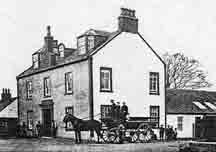The Newton Inn.
Newton Mearns, Glasgow.

Horse & Cart outside the Newton Inn. c1900.
The Newton Inn, was one of the most important buildings, from many points of view, in the pleasant upland village of Newton Mearns. It was important as a place of rest, as a place of entertainment and as an ornament to the village of which it was a portion. Situated on the most direct of the highways leading into Ayrshire, it was better known, perhaps, to travellers between Glasgow and Kilmarnock, Ayr and the south- western seaboard of Scotland generally, than any other inn throughout the length and breadth of Renfrewshire.

Drawing of the Newton Inn, Mearns. 1893.
It was built when the road was made, rather more than half a century from 1893, and was still in the same family. Mr James Russell, the proprietor, succeeded his mother in 1885, into whose hands the business passed at the death of her husband in 1880. The same succession to next of kin marks its earlier history.
Young Mr Russell, assisted by an experienced housekeeper, conducts the inn, which was a posting establishment as well as a hotel, in a way that few men of his years could. In addition to his ordinary duties as a hotel proprietor, he had to look after a stud of horses, ten or more, and was responsible for the maintenance of the coach connection between the village and Giffnock railway station.
Mr Russell was responsible for the green-house and large gardens on the land, walking through the gardens there was the various out-houses, hay shed capable of storing three thousand stones of hay, and another a little hall invaluable to the natives of the village and the more immediate neighbourhood as a resort for Halloween parties, dancing and all the other innocent amusements peculiar to peasant life. Passing through the conservatory, the inn had twenty apartments exclusive of cellars. The sitting-rooms were comfortable and simply decorated, the drawing-room and dining-room was tastefully furnished and the bedrooms clean and cosy.
The cellars, which were used for the storage of beer and the stronger stuff, exhibit, in the arrangement of their contents, a degree of order that surprised the visitor. From almost every window in the inn delightful views of the surrounding country may be enjoyed. One looking out on the village, another on the old parish church, while a third commands a distant view of the city half-hidden in haze.
Newton the name by which the village of Newton Mearns is locally known. It stands or touches upon what is still called by those living in the district the New road to Kilmarnock, at a distance, we shall say, of seven miles from Glasgow, and at an altitude of 420 feet, off and on, above sea level. Like Carmunnock it was not then reached by railway. The nearest railway station was in Giffnock, three miles away, with which it was connected by coach. It is a clean comfortable village and though of comparatively modern growth, possessed of an air of true rusticity. About half a mile away to the east is the village of Mearns proper. It is situated on the old road to Kilmarnock, long out of use as such, and is noteworthy chiefly because of the parish church, odd-looking, and yet of true Puritan plainness, which stands close by. Mearns manse, was the scene of the earlier education of John Wilson, "Christopher North."
"Who charmed us both with prose and rhyme,
While Pollok marked "The course of time'."
The Pollok here referred to is Robert Pollok, the author of The Course of Time, who was a native of the adjoining parish of Eaglesham. To the south of the village, occupied the summit of an eminence, stands the ruin of Mearns Castle. Apart from the castle, which to the antiquary has a special value, this spot is at once attractive and agreeable. It is a grassy knoll, from which, the intervals of the pine trees that grow on its slopes, a pleasing prospect of the meadows lying to the east of Newton Mearns and the adjacent country generally may be secured. In the trees alluded to, a community of crows collect annually and re-occupy the nests of the previous year, or, we might safely say, previous century, for they certainly look as old as the castle.
The highway on which the inn was situated was a favourite of the cyclists and would gather at the inn both as a meeting place and a place of refreshment. Nearly all the road-races were held at the inn which was usually the starting point, the villagers turned out and gathered to cheer the racers on, it was a real social community gathering.
End.
